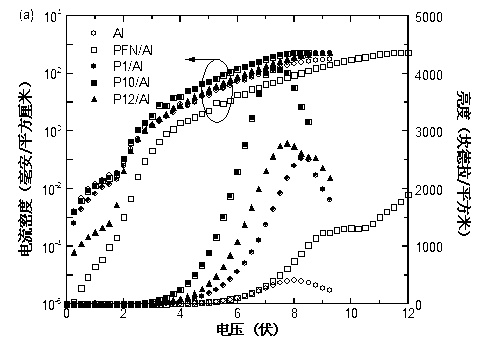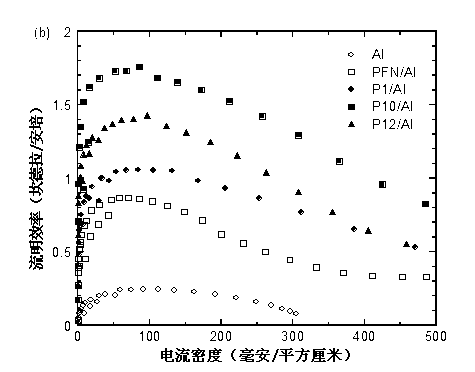S,S-dioxo-dibenzothiophene monomer containing polar substituent groups, water/alcohol soluble polymers thereof, and application thereof
A technology of dibenzothiophene and polar substituents is applied in the application field of cathode interface modification layer in light-emitting diodes and photovoltaic cell devices, and can solve uninvolved and other problems
- Summary
- Abstract
- Description
- Claims
- Application Information
AI Technical Summary
Problems solved by technology
Method used
Image
Examples
Embodiment 1
[0067] Example 1: 2,8-Dihydroxy-dibenzothiophene
[0068] Weigh thiofluorene (20 g, 108.7 mmol) and dissolve it in chloroform, add 0.31 g (54 mmol) of reduced iron powder, avoid light, add liquid bromine (14 ml, 271.8 mmol), reacted at room temperature for 20 hours. Then neutralize with saturated sodium bisulfite aqueous solution to remove unreacted liquid bromine, pour the reaction system into water, extract with dichloromethane, wash with saturated brine and distilled water, and dry over anhydrous magnesium sulfate. Spin dry and recrystallize with chloroform. 2,8-Dibromo-dibenzothiophene was obtained as white crystals. 1 H NMR (300MHz, CDCl 3 )δ (ppm): 8.24 (m, 2H), 7.71 (m, 2H), 7.58 (m, 2H). 13 CNMR (75MHz, CDCl3) δ (ppm): 138.99, 136.55, 130.68, 125.08, 124.58, 119.01. ESI-MS: m / z 342 (M+). Elemental analysis calculated value [C 12 h 6 Br 2 S] (%): C, 42.14; H, 1.77; S, 9.37; Found: C, 42.16; H, 1.83; S, 9.31. 2,8-Dibromo-S,S-dioxo-dibenzothiophene (3.42 g, 10 m...
Embodiment 2
[0070] Example 2: 3,7-bis(4,4,5,5-tetramethyl-1,3,2-dioxaborinane)-2,8-dioctyloxy-S,S-diox -Dibenzothiophene
[0071]Dissolve 2,8-dihydroxy-dibenzothiophene (10.8 g, 50 mmol) in N,N-dimethylacetamide, add potassium carbonate (20.7 g, 150 mmol), heat to reflux, and Stir for 2 hours under the protection of argon, add 1-bromooctane, and react for 24 hours. Then the system was lowered to room temperature, potassium carbonate was removed by filtration, the filtrate was poured into ice water, extracted with dichloromethane, washed with saturated brine and distilled water, and dried over anhydrous magnesium sulfate. Spin to dryness, and distill off N,N-dimethylacetamide under reduced pressure. The residue was purified by column separation (petroleum ether: ethyl acetate = 10:1 as eluent). 1 H NMR (300MHz, CDCl 3 )δ(ppm):8.22(d,2H),8.16(s,2H),7.06(d,2H),4.08(m,4H),1.73(m,4H),1.42(m,4H),1.29( m,8H), 1.25(m,8H), 0.88(t,6H). 13 C NMR (75MHz, CDCl 3 )δ (ppm): 158.54, 133.69, 132.52...
Embodiment 3
[0073] Example 3: 3,7-dibromo-2,8-bis(6-bromo-hexyloxy)-S,S-dioxo-dibenzothiophene and 3,7-bis(4,4,5, 5-Tetramethyl-1,3,2-dioxaborolane)-2,8-bis(6-bromo-hexyloxy)-S,S-dioxo-dibenzothiophene
[0074] Under the protection of an inert atmosphere, the prepared 2,8-dihydroxy-dibenzothiophene (10.8 g, 50 mmol) was dissolved in N,N-dimethylacetamide, and potassium carbonate (20.7 g, 150 mmol), heated to reflux, stirred for 2 hours under argon protection, added 1,6-dibromohexane, and reacted for 24 hours. Then the system was lowered to room temperature, potassium carbonate was removed by filtration, the filtrate was poured into ice water, extracted with dichloromethane, washed with saturated brine and distilled water, and dried over anhydrous magnesium sulfate. Spin to dryness, and distill off N,N-dimethylacetamide under reduced pressure. The residue was purified by column separation (petroleum ether: ethyl acetate = 10:1 as eluent) to obtain 2,8-bis(6-bromo-hexyloxy)dibenzothiophen...
PUM
| Property | Measurement | Unit |
|---|---|---|
| Thickness | aaaaa | aaaaa |
Abstract
Description
Claims
Application Information
 Login to View More
Login to View More - R&D
- Intellectual Property
- Life Sciences
- Materials
- Tech Scout
- Unparalleled Data Quality
- Higher Quality Content
- 60% Fewer Hallucinations
Browse by: Latest US Patents, China's latest patents, Technical Efficacy Thesaurus, Application Domain, Technology Topic, Popular Technical Reports.
© 2025 PatSnap. All rights reserved.Legal|Privacy policy|Modern Slavery Act Transparency Statement|Sitemap|About US| Contact US: help@patsnap.com



